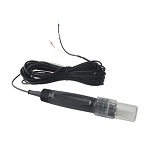Basic Components
Glass Membrane
The most critical part of a pH electrode is the glass membrane, which is sensitive to changes in hydrogen ion concentration. This membrane is typically made of a special type of glass that is selectively permeable to H+ ions.
Reference Electrode
In addition to the glass membrane, there is usually a reference electrode inside the electrode body. This reference electrode has a known and stable pH value, providing a reference point for the measurement.
Junction
The electrode typically has a junction where the internal electrolyte and the solution being tested come into contact. This junction allows ions to flow between the internal reference solution and the external solution, facilitating the measurement process.
When the pH electrode is immersed in a solution, the glass membrane selectively allows hydrogen ions to pass through it based on the difference in hydrogen ion concentration between the solution and the reference electrode's internal solution. This generates an electrical potential (voltage) that can be measured. The voltage is then converted into a pH value using a pH meter or pH analyzer.
pH Electrodes Price List
To help you make a better choice, here is a price list of sisco for you.
| Product picture | Product name | Function | SKU | Price |
 |
Combination pH Electrode | For Wastewater | SISCO-PHE-5011 | $112.69 |
 |
Glass pH Electrode | For Pure Water | SISCO-PHE-5020 | $183.49 |
 |
pH Electrode | For Flue Gas Desulfurization | SISCO-PHE-5012 | $199.37 |
 |
pH Electrode | For Strong Acid/Alkali/High Temperature | SISCO-PHE-5013A | $179.92 |
 |
pH Glass Electrode | For High Pressure | SISCO-PHE-6020 | $351.75 |
 |
pH Glass Electrode | For High Temperature | SISCO-PHE-5018 | $206.68 |
 |
pH Glass Electrode | For High Temperature/Sterilization | SISCO-PHE-5050 | $536.16 |
Instructions For the Proper Use
Prepare the pH Electrode
- Ensure the electrode is clean. If it has been used previously, rinse it with deionized water and gently blot it dry with a lint-free tissue.
- If it's a combination electrode (with a reference electrode built-in), ensure that the reference chamber is filled with the appropriate reference solution, often a potassium chloride (KCl) solution. Some electrodes come pre-filled
Calibration
- Before use, it's essential to calibrate the pH electrode to ensure accurate measurements. You will need at least two standard buffer solutions, typically pH 4.01, pH 7.00, and pH 10.01 (for general applications).
- Immerse the electrode tip in the pH 7.00 buffer solution and allow it to stabilize. Adjust the meter to read 7.00 if necessary.
- Rinse the electrode with deionized water and blot it dry.
- Repeat the process with the other buffer solutions (e.g., pH 4.01 and pH 10.01). Always start with the most acidic buffer and finish with the most basic.
- If the readings don't match the expected pH values, adjust the calibration as needed.
Sample Measurement
- Rinse the electrode tip with deionized water to remove any residue from the calibration.
- Immerse the electrode into the sample solution to be measured. Ensure that the junction on the electrode is fully immersed.
- Allow the electrode to equilibrate in the sample, typically for a few minutes until the pH reading stabilizes. Stir gently if necessary.
- Record the pH value.
Rinse and Store
- After measurements, rinse the electrode with deionized water to remove any remnants of the sample solution.
- Place the electrode in a storage solution (often a 3M KCl solution) to keep it hydrated and maintain the reference electrode's stability. Avoid storing it in deionized water, as this can damage the electrode.
Maintenance and Cleaning
- Regularly clean the electrode with a suitable cleaning solution, following the manufacturer's instructions. This helps remove any contaminants that may accumulate on the glass membrane.
- Replace the storage solution and the reference solution as needed, per the manufacturer's recommendations.
- Handle the electrode carefully to avoid damage to the glass membrane, as even minor damage can affect accuracy.
Troubleshooting
- If you encounter issues with the electrode's performance, such as unstable readings or drifting pH values, it may require recalibration or replacement.
- If the electrode has been unused for an extended period, it may require conditioning before use, which involves soaking it in the reference solution for some time.

